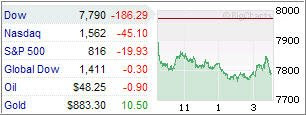In last Saturday’s post, I talked about the current bear market rally, which struck a hot button with several readers. Ray left an excellent and detailed comment, which I will use as a basis for today’s post since it covers an important area of investing. Here’s a portion of what he said:
Patience is a virtue that has tripped up many an investor, including the author of this note over the years. As you look at monthly charts and see a rally since March 9, all of us wish we were invested to catch some of the explosive upside. Unfortunately, you might as well double down in Vegas, because (as you have written) there is no way of seeing the bottom until it is in and replaced by a solid trend reversal.
Ulli, your work allows us to do exactly that. I have recently checked some of the mutual funds I sold on your last sell signal in June and was not surprise to see some of them down as much as 60% from that sell signal, even with this rally—-you can only imagine how glad I am to miss this past rally for the opportunity to have saved my portfolio. All I need to do is figure how much of a return I would need to break even (if I had not sold them) to keep my hands off the BUY KEY—-But I am still as anxious and impatient as I have even been. I have found that over the years I have been able to make far more money by not loosing it in the bears, and I must give you the credit for allowing me to keep my emotions in check.
This brings up an interesting point. When investing, we all like to maximize our gains and minimize our losses. However, since this can rarely be done on purpose, the question remains whether one could be more important than the other? In other words, over a period of time, is it more critical to maximize your gains or to minimize your losses?
Reader Ray has found that not loosing it during a bear market has made a big difference to him, and I agree with that. To look at some real numbers, let’s review again a table I posted in my free e-book “The SimpleHedge Strategy:”
It shows the annual returns of the S&P; 500 for this century vs. a hedged buy-and-hold strategy, which I don’t advocate but which I have used in this example. As I have mentioned before, when comparing any kind of returns, especially the ones the buy-and-hold crowd publishes, you need to always include a bearish period. Otherwise, you might be misled to conclude that a certain mutual fund or ETF only heads for the skies.
This table clearly shows the good, the bad and the ugly when it comes to returns. If you are trying to maximize your gains, you have to be invested all the time, which will result in your portfolio receiving severe haircuts when the bear strikes. Of course, during years like 2003 and 2006, you’ll be running around pounding your chest by seeing your assets perform so well.
On the other hand, a strategy minimizing your losses clearly has merits when the bear hits hard and you are safely on the sidelines or in a hedged position.
It all comes down to the time frame you use for your evaluation. For example, looking at only one year to evaluate anything is short-sighted and does not give you enough data to base a decision on.
My experience has shown that a conservative strategy, such as trend tracking, which does not necessarily give you the highest returns possible during good times, but avoids the pitfalls of a bear market during sharp corrections, will be far superior over time. The above table, while representing only one period in history, clearly supports that view.
This goes along with a general theme in life in that it’s not how much money you earn, it’s what you keep that matters. It’s the same with investing.






